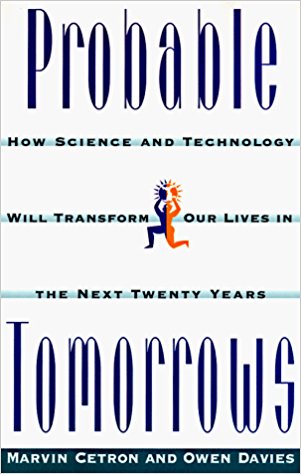Probable Tomorrows Summary

<1 min read ⌚
 How Science and Technology Will Transform Our Lives in the Next Twenty Years
How Science and Technology Will Transform Our Lives in the Next Twenty Years
You, just like everyone else, are probably wondering how the future will play out.
What changes can you expect? How will humans evolve?
In our summary of “Probable Tomorrows,” we give you a glimpse of what you can expect to happen.
Who Should Read “Probable Tomorrows”? and Why?
In “Probable Tomorrows” authors Marvin Cetron and Owen Davies study expected trends in technology over the next two decades.
They categorize their material under the Internet, digital systems, nanotechnology, transportation, high-tech materials, space, medicine, energy and environmental remediation. An appendix list at the end of the book presents each prediction along with the probability of it happening.
As expected, just like most of the books written in the previous century, concerned with predicting the future, some of the predictions are already dated.
However, despite that “Probable Tomorrows” remains a rich source of interesting ideas. We recommend this book to all long-term thinkers.
About Marvin Cetron and Owen Davies
 Marvin Cetron Forecasting International’s founder and president. He has been a consultant for more than half of the Fortune 500 companies in the U.S. and numerous government agencies internationally.
Marvin Cetron Forecasting International’s founder and president. He has been a consultant for more than half of the Fortune 500 companies in the U.S. and numerous government agencies internationally.
Owen Davies is a freelance writer specializing in science, technology and the future and a former editor at Omni magazine.
Together, they wrote several books, among which “Probable Tomorrows”.
“Probable Tomorrows Summary”
In “Probable Tomorrows” the authors predict that ten years from the moment they are writing their book, computers will be almost everywhere.
Of course, almost 20 years have passed since their predictions, so most of the changes they talk about have already happened. As they argued, formerly separate technologies have merged, which affected telephone, radio, and computers.
Furthermore, they talked about microchips which they expected to get smaller and faster, thanks to the sophisticated design. They could see chip designers beginning to reach the limits of miniaturization, and beginning to use x-ray lithography.
They predicted the development of DNA computers which would be able to represent binary data as DNA patterns, and as a result, use chemical reactions to solve problems.
At the moment DNA computers are already advanced, but it takes as long as a week to get their results. Quantum computers are a not a development in sight, but optical computers, on the other hand, could come into use very soon.
Furthermore, in the near future, most people will gain access to new, powerful online networks.
Manufacturers are already adopting just-in-time manufacturing, which helps them keep inventory to a minimum. To be possible, JIT requires a chain of suppliers who can deliver products instantly and a stable flow of information at all stages of the manufacturing process.
When manufacturers and suppliers network their computers, their system becomes more efficient.
What does this translate to?
It means that better customer service and higher profits are on the horizon.
In 10 years from now, customers will be able to order exactly the products they want online since most companies will route orders over the internet. E-commerce is already widespread, and it will continue to advance in the years to come.
The Internet, which we are already used to, threatens to create a two-tiered society: an upper class of users and an under-class of non-users.
Some people argue that everyone should have access to the web since it was created with public funding. However, there is a possibility that government or mandatory private subsidies fund it, and therefore limit it.
But, stay calm. So far, when it comes to the internet, the free market rules.
Key Lessons from “Probable Tomorrows”
1. Nanotechnology: Engineering, One Atom at a Time
2. Nursing an Injured Planet
3. Medicine for the New Millennium – Making Aging Stop
Nanotechnology: Engineering, One Atom at a Time
Soon, people will stop building specific sorts of products by hand. Instead, time will come when virus-sized machines will develop goods from raw materials. This nanotechnology would alter medicine, empowering doctors to tinker with single cells or unclog arteries.
Nursing an Injured Planet
The most worrisome environmental issues of the next years include:
- A considerable clean-up will need to address environmental damage in the former Soviet bloc, especially Russia.
- Science will finally pin down the impact of industry on the environment, including both the greenhouse effect and the effects of sulfate compounds.
- Loss of ozone will continue to increase health risks all around the world.
Medicine for the New Millennium – Making Aging Stop
Numerous new treatments will be available to patients. Among the most important are:
- Gene therapy: Doctors will use man-made viruses to alter genes in the cell.
- Hormone replacement therapy: Increasing levels of various hormones may succeed in stopping the symptoms of aging.
- Rejection-free transplants: New drugs will make it possible for transplants to happen without the need to match organ donors and recipients. As a result, even animal organs will be usable, or organs that science tries to grow in vitro.
Like this summary? We’d Like to invite you to download our free 12 min app, for more amazing summaries and audiobooks.
“Probable Tomorrows” Quotes
Technology is the dominant force of our time and probably of all time to come. It permeates and shapes our lives at every turn. Share on X The next 10 years will fix the character of the Net, probably for decades to come. Share on X Until recently, it took some four decades for the discoveries of pure science to find their way into the everyday miracles of technology. Today, that development cycle has been reduced to a few months. Share on X The first decade of the 21st century will be one of the most remarkable and productive in the history of medicine - not just in history to date but in all the history there will ever be. Share on X Already it is becoming inescapably clear that few environmental problems will wait until we find it convenient to deal with them. Share on XOur Critical Review
“Probable Tomorrows” is a well written and easily readable book. The problem is that like the most book which tries to predict the future; it got outdated. It was undoubtedly interesting to read in 1997 when the authors published it, but today’s readers will find it describing the world we already live in today.
Having that in mind, we have to give it to the authors, since they made some pretty accurate forecasts of the future.







